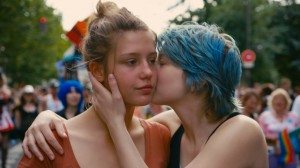
 This year's Palme d'Or winner at the Cannes Film Festival has absolutely none of the trappings of a mainstream success. It centers around a lesbian love story. It contains extended, graphic sex scenes. It was slapped with an NC-17 rating by the MPAA. It runs three hours long. And it's all in French (admittedly only a problem if you don't speak the language). But "Blue Is The Warmest Color" is also an honest, raw, engaging film that's not content to simply tell a story; rather, it aims to create, from thin air, an entire person -- a fully-dimensional, flesh-and-blood person with hopes, flaws, strengths, weaknesses and dreams.
This year's Palme d'Or winner at the Cannes Film Festival has absolutely none of the trappings of a mainstream success. It centers around a lesbian love story. It contains extended, graphic sex scenes. It was slapped with an NC-17 rating by the MPAA. It runs three hours long. And it's all in French (admittedly only a problem if you don't speak the language). But "Blue Is The Warmest Color" is also an honest, raw, engaging film that's not content to simply tell a story; rather, it aims to create, from thin air, an entire person -- a fully-dimensional, flesh-and-blood person with hopes, flaws, strengths, weaknesses and dreams.
Known in France under the more accurate title "La vie d'Adèle", the film depicts the life of its protagonist in a tale spanning several years of her life. When we first meet Adèle (played by the wonderfully accessible Adèle Exarchopolous), she's a confused 15-year-old high school junior who loves reading but is getting no fulfillment from her flirtations with a young Ethan Hawke lookalike. By the end of the film, she's in college, working as a teaching assistant in a kindergarten, having been through a roller coaster of experiences including falling in love and having her heart broken -- experiences that will be intimately familiar to almost any viewer. The film and its director, Abdellatif Kechiche, make almost no distinction between such mundane acts as eating or sleeping and such momentous occasions as a first kiss or an apocalyptic fight. Every moment of Adèle's life, small or large, is essential: they're all integral in forming the portrait of her existence. That sense of completeness is sadly unusual for a film character. The fact that this feat takes three hours to accomplish may try the patience of some audience members, but in this reviewer's humble opinion, it is a rewarding experience well worth undertaking.
As Adèle, Ms. Exarchopolous is truly astounding. She's believable both as a curious and naive young student and as a more weary, worldly teacher. There's not a single scene she doesn't appear in -- not a small task for such a long film. The camera hardly ever leaves her side, lingering lovingly over her face, registering every subtle reaction, every small smile, every single tear. And what a face. With her observant eyes, cherubic cheeks, and untamable hair, she's the picture of childlike innocence. Watching her face is like looking through a window into her thoughts. She can say more while silently watching her lover from afar than other actresses could say given a wordy monologue. It's a performance of such openness, such vulnerability, that at times, the film feels like a documentary.
As Adèle's lover, Léa Seydoux is also brilliant. American audiences may be more familiar with her than with Ms. Exarchopolous because of her roles in films such as "Inglourious Basterds" and "Mission: Impossible - Ghost Protocol", but even still, Ms. Seydoux disappears entirely into her role as experienced, intelligent art student Emma. With her wild coif of blue hair, her easy smile and her passionate ramblings on art and painters, Emma is simultaneously an enigma, and a person utterly familiar to all. Everyone knows an Emma, who can easily hold an audience captive at a party, engaging everyone with her smile and her endless fountain of little-known facts. It's that person that Adèle falls in love with. But who is that person behind closed doors? Once Adèle starts peeling back Emma's layers, will she still love what she finds? "Blue" isn't Seydoux's film in the way that it is Exarchopolous' (she doesn't appear except in passing until almost an hour in), but she deserves her own recognition. It's a testament to the power of both these young women that Cannes awarded the Palme d'Or jointly to Kerchiche, Exarchopolous and Seydoux. The prize is traditionally given to a film's director, and this is the first time in history it has ever been presented to actors.
It's refreshing to see a film portray a homosexual relationship at its core that doesn't pigeonhole itself as a "gay" movie. "Blue" doesn't spend its runtime tackling important social issues. There's no climactic, confrontational coming-out scene. Sure, Adèle and Emma march in a Pride parade, and yes, there's a scene where Adèle has to confront prejudice from a hateful peer. But these scenes are not centerpieces of the story; they are just moments that complete the portrait of Adèle. This isn't a movie "about" lesbians. It's a movie about the joys and pains of love, whose core sentiments are familiar and relatable to anyone who's been in a relationship.
[youtube]https://www.youtube.com/watch?v=DfpOSmvzAW0[/youtube]